www.jb-electronics.de » Elektronik » Nixie-Röhren » Geschichte der Nixie-Röhre
Geschichte der Nixie-Röhre
Dieser Artikel ist zur Zeit nur auf Englisch vorhanden: Link
www.jb-electronics.de » Elektronik » Nixie-Röhren » Geschichte der Nixie-Röhre
Dieser Artikel ist zur Zeit nur auf Englisch vorhanden: Link
www.jb-electronics.de » Electronics » Nixie Tubes » History of the Nixie tube
An historic device like the Nixie tube that has dominated a whole branch of the electronics industry sure must have an interesting history. This is what I thought when I first got into the field of Nixie tube collecting. As it turned out, it is far more difficult to find information on the Nixie tubes' origins than you would actually assume.
Although there is a lot of information available on the net, the problem with these articles is that most are either too superficial, or speculative without any prove.
This is why I started to write this article. With the help of many sources and contributors a plausible, historically proven historical timeline of the Nixie tubes' origin could be pieced together. It should be noted, though, that as of now the article strongly focuses on the American side of the story, where - according to my current knowledge - the Nixie tube originated. Further research still has to be done to cover the history in Europe. Nevertheless, enjoy what is here so far!
The effect of the glow discharge that is most commonly used with glow lamps has been well known since the mid of the 19th century. So-called Geissler tubes already used glass bulbs filled with noble gases under low pressure for creating various light patterns [1].
It is no wonder that from 1920 to 1940 there were numerous patents in the area of glow discharge tubes. However, the difficult part is to to determine the first true indicator tube, that was able to display information, i.e. transform an imcoming signal into readable information.
It is international understanding amongst the Nixie tube collectors that the US patent 2142106, filed on May 9, 1934, issued Jan 3, 1939, from Hans Paul Boswau fully describes the first actual indicator tube known worldwide.
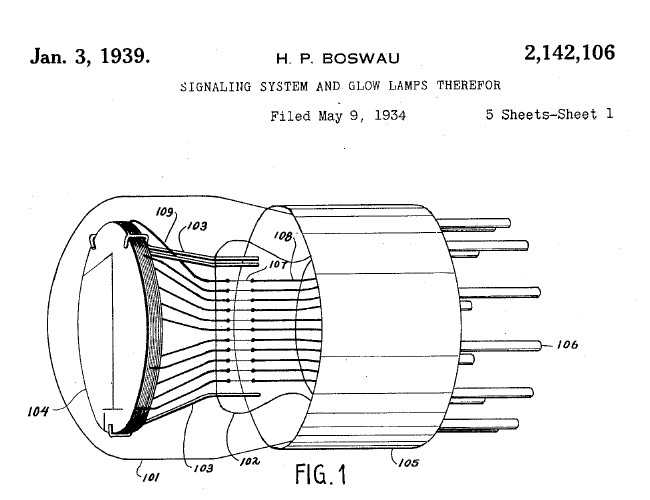
The patent can be downloaded here: US2142106.pdf (907 KB).
There might be other patents from other countries from earlier times, but this is the historically first evidence of an indicator tube known until today. Other countries' patents databases are not as easy to search as the US patent database, this is why it is only safe to say that patent US2142106 is most likely the first American indicator tube patent.
The early date of 1934 is quite striking, since we have no information about indicator tubes being produced at this time. According to H. P. Boswau's daughter, Boswau himself was a tinkerer by all means and would often work late in his basement lab. It is likely that his glow tube - as he called his invention - never made it out of there. [2]
After 1934 not too many readout tubes in our sense appeared.
The first US patents that resemble a readout tube were filed in 1950 by assignors to Northrop Aircraft Inc., namely US2618697, US2618760, US2632128, US2723365, US2735038, US2769939. The first patent was filed June 12, 1950, and the first patents were issued November 18, 1952. The last patent was issued in November 6, 1956.
Here are some pictures:

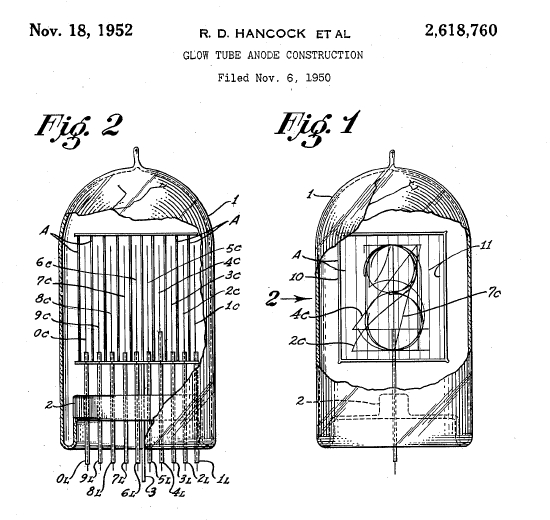
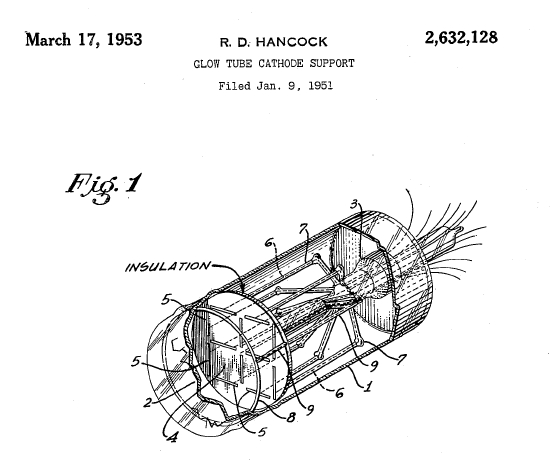
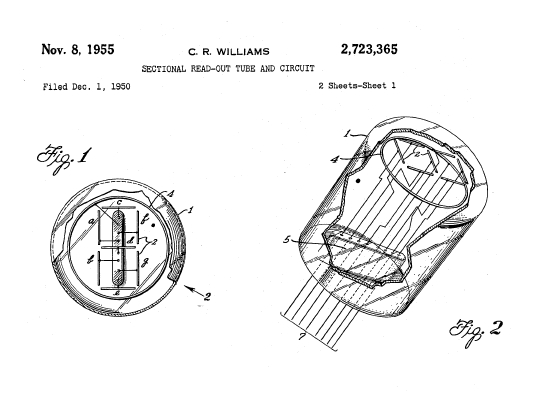
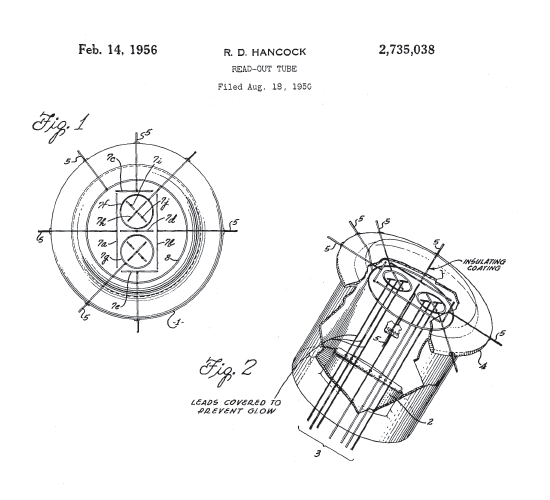
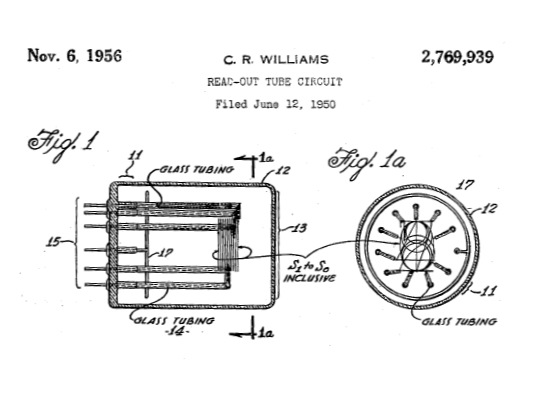
Northrop Aircraft Inc. was a company that had been founded 1939 [3] and was focused on the production of aircraft for US military. These patents are the only ones ever assigned to Northrop Aircraft Inc., and there is no historic evidence that Northrop has ever manufactured these indicator tubes under their roof.
Also, the relatively short time span of two years between the filing and the issuing of the patents above suggests that there was not much competition around at that time these patents could have conflicted with.
In the early fifties National Union, a company formed by the merger of Magnatron, Marathon, Sonatron and Televocal in 1929 [4], appeared in the field. April 1, 1954, assignors to National Union filed patent US2756366:

Only one month later, National Union released the datasheet for their GI-10 Inditron tube:
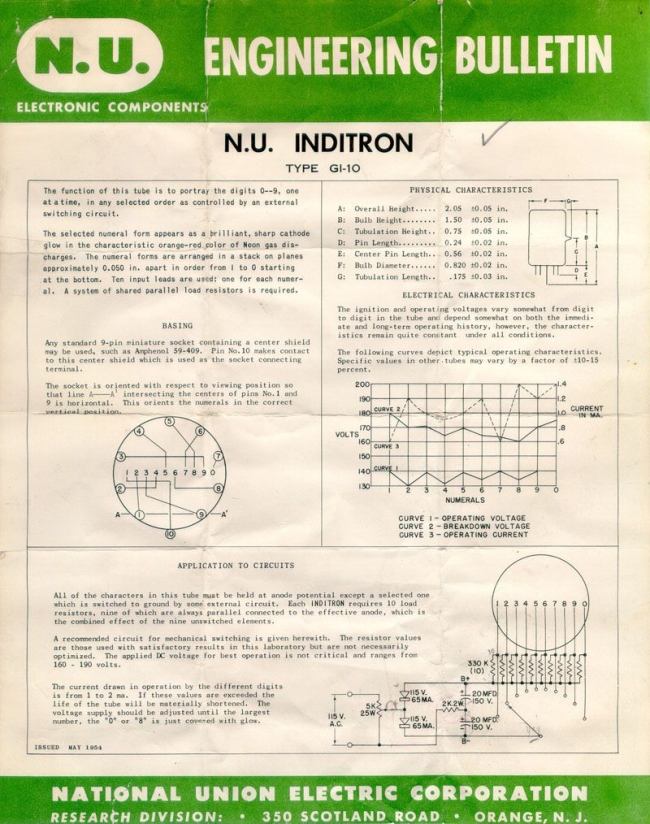
A higher resolution image can be downloaded here: data_GI-10.jpg (192 KB).
The similarity between the tube depicted in the patent and the GI-10 are striking. Other sources confirm that the GI-10 has been released as early as 1954, here is an extract from the magazine Popular Electronics, dated September 1954:
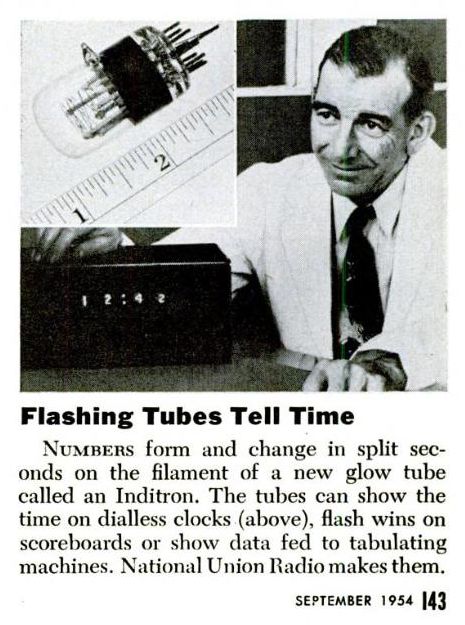
As it turns out, the GI-10 and GI-21 are not the only tubes from National Union's Inditron series, as an undated promotion sheet reveals:
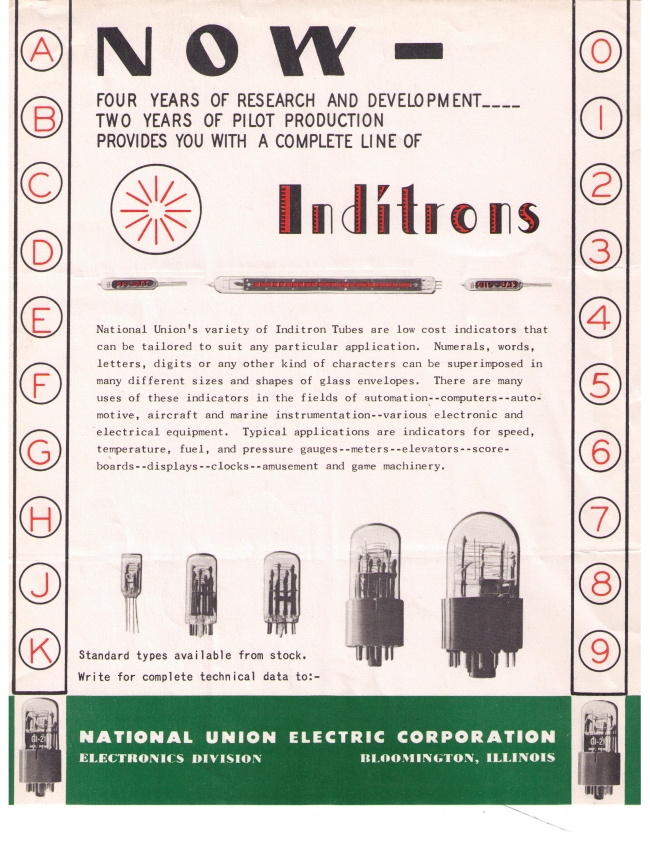
A higher resolution image can be downloaded here: inditron_promo_sheet_large.jpg (1.14 MB).
Although undated, it is assumed that this promotional sheet cannot have been issued earlier than May 1954, because for providing complete technical data on the Inditrons upon request the datasheets already had to exist at the time the promotional sheet was issued. And we know that the GI-10 datasheet is from May 1954. To be fair, the GI-10 as we know it today is not depicted on the sheet, so the dating of 1954 of this promotional sheet is an assumption.
Based on that assumption, the headline stating four years of research and development_ _ _ _ two years of pilot production implies that National Union might have been plannig these tubes from 1954 minus 4 to 6 years, that is 1950 to 1948. Interestingly, this is the time period in which Northrop Aircraft Inc. filed some of their patents. Maybe - this is conjecture - Northrop's ideas and concepts were sold to National Union.
National Union's Inditrons were not the only readout tubes around at that time. Haydu Brothers, a manufacturer of electron tubes had been bought by Burroughs in 1954 [5], and 1955 the first Nixie tube advertisements depicting the HB-106 appeared:
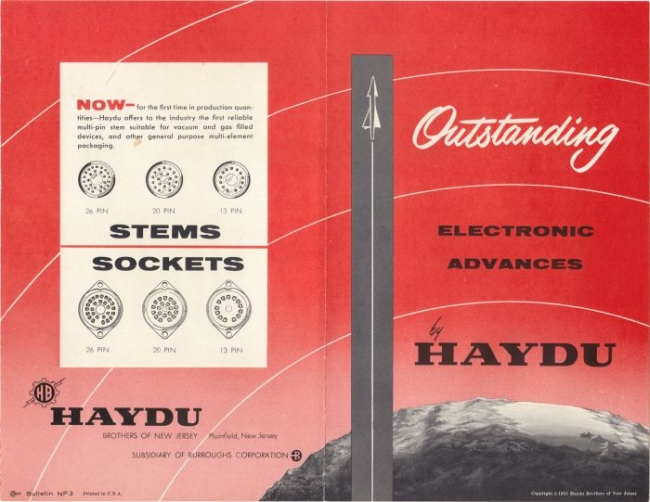
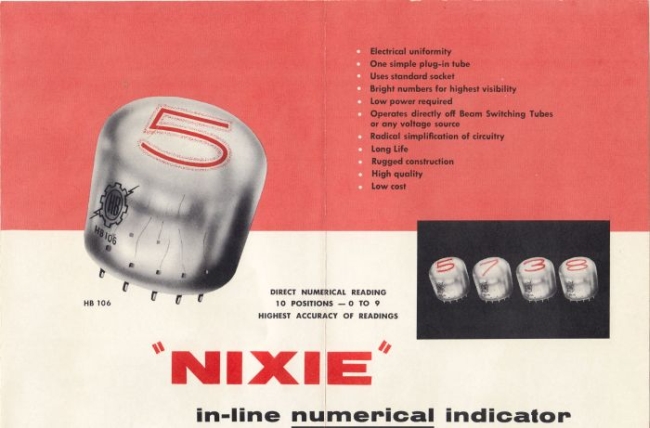
See higher resolution pictures here: haydu_bulletin_1_large.jpg (1.34 MB), haydu_bulletin_hb106_large.jpg (1.06 MB).
These two pages come from a Haydu bulletin that has 1955 printed on the bottom of the page. Another advertisement is seen here:
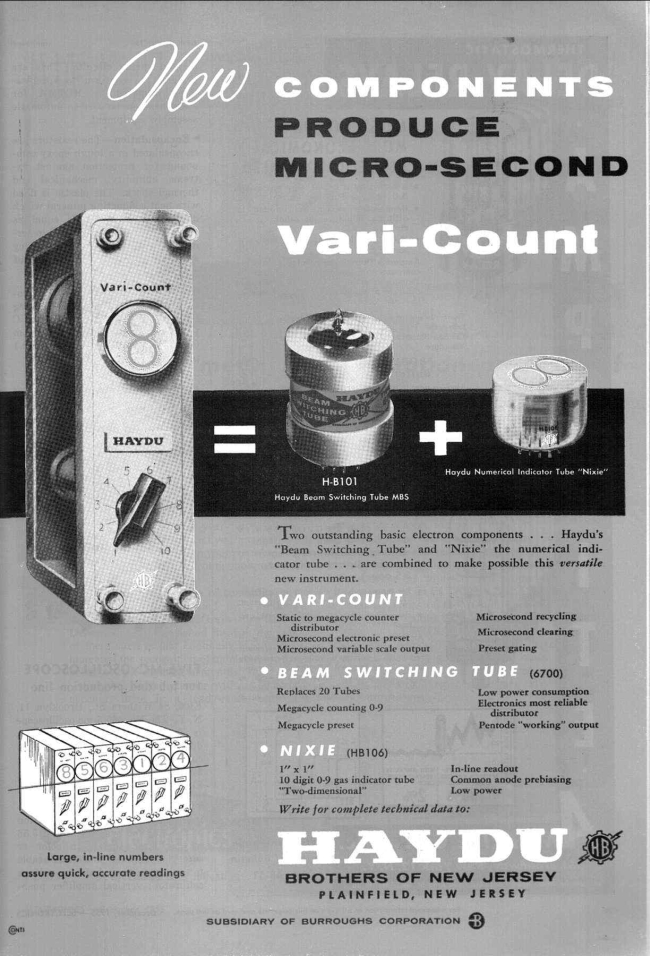
This advertisement is dated December, 1955 [6].
It is a common misconception that Haydu Brothers developed the Nixie tube themselves. There is no historical evidence for that, although several websites propagate this theory. The advertisements above are ambiguous. The tubes are labelled HB, most likely after Haydu Brothers, but on every ad it says Haydu Brothers - a subsidiary of Burroughs corporation, indicating that Haydu Brothers had already been bought by Burroughs and was thus not marketing an own product line.
After digging a little deeper, I have found that apparently Burroughs purchased Haydu Brothers in 1954
... to produce special purpose electronic tubes for data display which have resulted from research at the Paoli laboratory. [7]
The point is that Burroughs apparently planned the Nixie tube at their Paoli research center [8] and bought Haydu Brothers solely for manufacturing purposes. This theory is hardened by another source:
Burroughs purchased the Haydu plant in 1954 expressly for the purpose of manufacturing and selling new products developed at our Paoli, Pennsylvania facility. One of the first new products, the NIXIE tube, started the division on the road to success. [9]
(Ed. Lord, Editor, the Burroughs Readout, Volume 1, Number 5, July 1972)
Additionally, former Burroughs employee Roger Wolfe confirms this theory. He worked for Burroughs at the Haydu Brothers location since 1954, shortly after the acquisition. He remembers that
... [t]he original incentive to purchase Haydu was to obtain a manufaturing facility for the Beam Switching Tubes (also called a trochotron) that were under development at the Burroughs Research Center in Paoli, PA.
Another logical element underlines this theory: The first electron tube made by Burroughs was the Beam Switching Tube, as confirmed by Roger Wolfe. However, these tubes lacked the possibility to indicate their state. It is only logical that Burroughs then set down to create such a display element.
With all that stated by independent sources, it becomes very clear that Haydu Brothers had no involvement in the development of a Nixie tube prior to the acquisition by Burroughs.
The extensive patent material shows that National Union beat Burroughs by the nose. What it does not show, though, is the story of Saul Kuchinsky, who played an important role in the Nixie tube's history: Being a former National Union employee [10] he worked at the Burroughs Research Center in 1954, allowing him to contribute knowledge gained at National Union while trying to build the first readout tubes there.
Yes, Saul Kuchinsky was a former employee of National Union. I don't recall much about his employment there, but they and others were experimenting with various gas display and counting tubes at that time so it is reasonable to think that some of his thinking originated with his experiences there.
(Roger Wolfe)
Although this information is not dated it is a key point because it provides a logical framework for the theory that National Union was in fact first.
The next step Burroughs took was filing a trademark request for Nixie in December 1956 [11]:
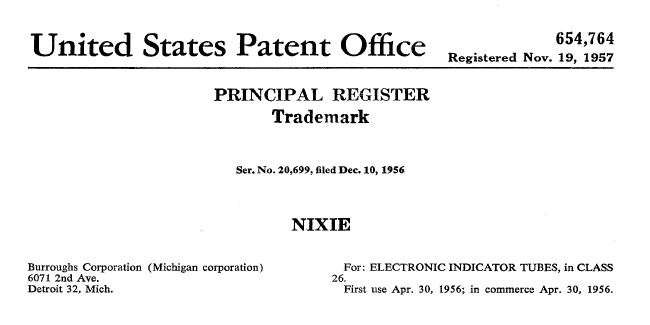
It was about this time that Burroughs abandoned the HB prefix indicating the Haydu Brothers involvement in the manufacturing process:
Later on, I believe it was in 1956, Burroughs changed the operation to a Division called the Electronic Tube Division and dropped the Haydu name.
(Roger Wolfe)
On Dec 13, 1955, the first Burroughs patent (US2874320) for a readout tube was filed, and then issued on Feb 17, 1959. This large time span of more than three years may be due to the start of a readout tube industry at the time.
After that, the rise of a new industry began, and the Nixie tube became an integral part of electronic devices. How exactly that happened remains to be seen.
Although the above gives a fairly good overview over the events in America, the following questions are not yet answered:
If you can help, please contact me. Any input is greatly appreciated!